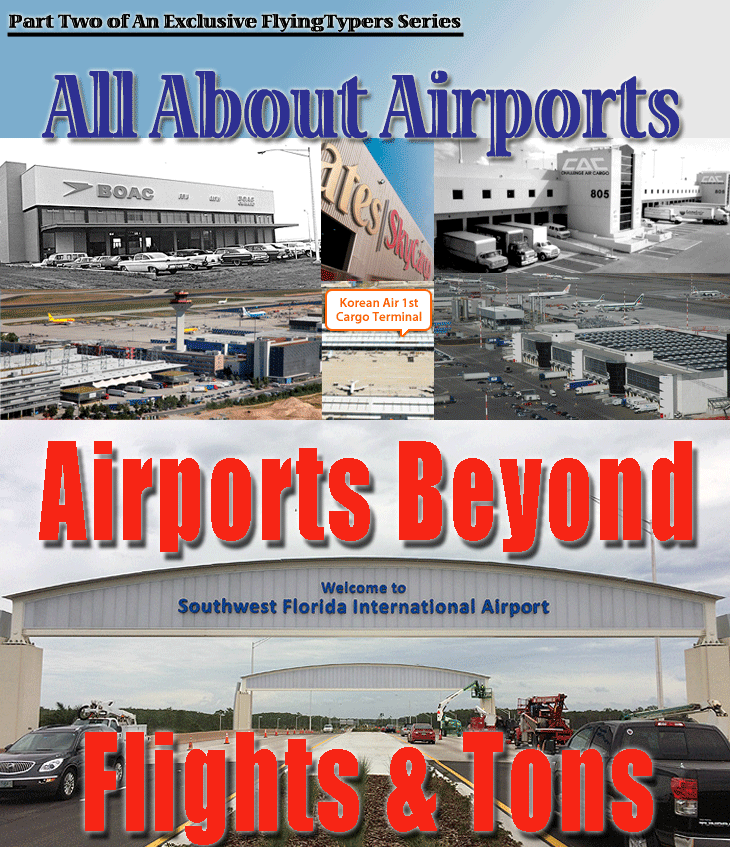
Here
is Part Two of our year-long series focusing on airports.
The following are some suggestions about what airports
can do to better serve the industry, specifically directed
to airport operators worldwide.
Yes, FlyingTypers is presenting a series that goes beyond the norm for
editorial about airports. We’re asking airport
operators to talk about what they are doing in 2016
to advance their business.
While highlighting the
airports, our motivation is to open the conversation
to involve everyone.
If you are an airport,
what are you doing about it?
If you are an airline
or forwarder, what can airports do to better serve the
need?
Write
to me and have your voice heard.
Here
is a link to the first story in our series.
We hope to hear from
you soon.
If
Unique Is What You Seek
An airport’s
never-ending quest to remain a self-sustaining enterprise
has driven their owners and operators to seek unique
ways to enhance both aviation and non-aviation revenues.
During the past few decades,
many commercial airports have modified agreements with
their airline partners in order to claim a more substantial
portion of revenues generated. In turn, airports have
gone beyond traditional sources to leverage lucrative
food and beverage, retail, car rental, ground transportation,
communication and technology services, fuel sales and
flowage fees, and parking and advertising agreements
with their business partners.
Others have found assets
unique to their situation or geography, such as underground
petroleum, natural gas deposits, or simply the decision
to offer in-house ground handling or FBO services, all
of which offer the financial flexibility and independence
an airport needs to be financially sound.
No
Two Airports Are Alike
Airport
business models can vary, given available resources,
political climate, and the need for diversified revenue
streams, but one constant for airports of all sizes
is to provide the infrastructure for air transport to
connect people and goods to the world’s resources
and markets.
For that very reason,
airports play a critical role in the area’s transportation
system. Most, if not all, act as multi-modal facilities,
connecting air transport to ground-based road, rail,
and/or marine facilities. Many connect to major transportation
arteries, providing unique opportunities in support
of moving people and products worldwide.
Definitions
Matter
Logistics
is defined as the planning, implementation, and coordination
of the details of a business or other operation.
Although some may see
this as an overly simplistic way to explain a complex
operation, it is evident airports play a major role
in helping entities plan and complete their logistical
process(es).
Not every corner of the
earth can produce major quantities of goods sought worldwide,
nor can every airport be a major air cargo center.
However, in our global economy, most people and businesses
are consumers of things that originate elsewhere and,
in many cases, are somewhere far away. Airports are
the means of bringing those goods to locations near
us, whether that means they arrive on hundreds of flights
a day or, in more remote regions, by one piston-powered
aircraft a month.
Major
To Minor Note Cargo
So your
airport isn’t a major or even a moderate air cargo
center… now what? Start by thinking about what
your airport provides for your community and where it
is located in relation to other modes of transportation,
infrastructure, population centers, or even other countries
and continents.
Air cargo operators are
unique businesses, but have similar needs like any other
company.
It is in this arena where
your airport might be able to help support the industry
beyond moving tons of product on multiple wide-body
airplanes. In fact, you
may already be supporting air cargo in ways you don’t
even realize.
Land leases, both aviation
and non-aviation, are just another way airports have
been able to add revenue to their bottom line and, given
the large air cargo industry worldwide, there are many
opportunities to offer something more than just traditional
air freight facilities.
Build-To-Suit
Airports
with substantial non-aviation lands can offer space
for build-to-suit warehousing and sort facilities, often
with room to grow such operations as the business matures.
Given the multi-modal
nature of airports, proximity to county, state, and
interstate highways, rail lines and seaports make many
airports a perfect location for unique facilities.
Some airports have existing
infrastructure, such as buildings that can be repurposed,
as well roadways, utility corridors, parking lots, etc.,
to keep development costs low. Other airports have also
invested in available parcels, making them “pad-ready”,
which allows for faster and less complicated development
timelines with much of the zoning and permitting in
place.
The lease-versus-buy
nature of airport land allows potential tenants the
ability to lock in lengthy terms without having to outlay
money for land acquisition, which is another consideration
for companies watching their cash flow.
Concurrently, airports
with aviation land available or land connected to the
airfield, e.g., taxiways and runways, in-house or third-party
maintenance, and repair and overhaul (MRO) facilities
for aircraft operators of all sizes can be accommodated.

Southwest
Florida Success
For
example, Southwest Florida International Airport successfully
partners with an air cargo operator by allowing pre-service
aircraft staging of their wide-body freighters on a
former terminal apron, which offers ease of access at
pre-negotiated rates.
Along these same lines,
aircraft conversion centers specializing in converting
passenger aircraft to cargo aircraft need aviation facilities
to perform their work.
Given the mobile nature
of airplanes, these types of facilities can be anywhere
in the world and often end up in areas not driven by
cargo tons, but by a specially trained and skilled workforce.
Recognizing
Opportunities
Air
cargo companies also need headquarters and regional
support space to conduct their “behind-the- scenes”
administrative work.
Once again, airports
with non-aviation lands or repurposed facilities can
provide low-cost alternatives for these functions. From
finance, sales and marketing, communications, business
development, governmental affairs, information systems,
human resources and contract management to crew scheduling,
dispatch, training, flight ops, etc., people in traditional
office settings need a home.
A commercial airport
with adequate, nonstop flights to major national and
worldwide destinations might be the perfect spot for
an air cargo company on the move.
Adaptive
Reuse Accompanies Change
At Southwest
Florida International Airport, a 2005 move to a new
terminal complex opened up more than 1,200 acres of
aviation and non-aviation land for development.
Branded as Skyplex and
equipped with roadways, parking, and utilities, this
is the type of opportunity an airport can turn into
a long-term investment for a cargo corporate office.
The
Imaginative Way Ahead
As you can see, there are numerous ways to support air
cargo at your airport.
Cargo facilities that
include air freight buildings and aircraft ramps are
important and should be part of any airport master plan;
however, don’t sell yourself or your airport short
when considering the different ways you can support
the air cargo industry and all it has to offer. Concentrate
on the key strengths of your airport and your community
and design a plan to capitalize on those assets.
Set your sights beyond
the number of air cargo flights and tons being transported
through your airport.
You might be surprised
to find out you are already supporting air cargo in
ways you never envisioned!
Geoffrey
To Read Part
I Of This Series Click Below
|
|





